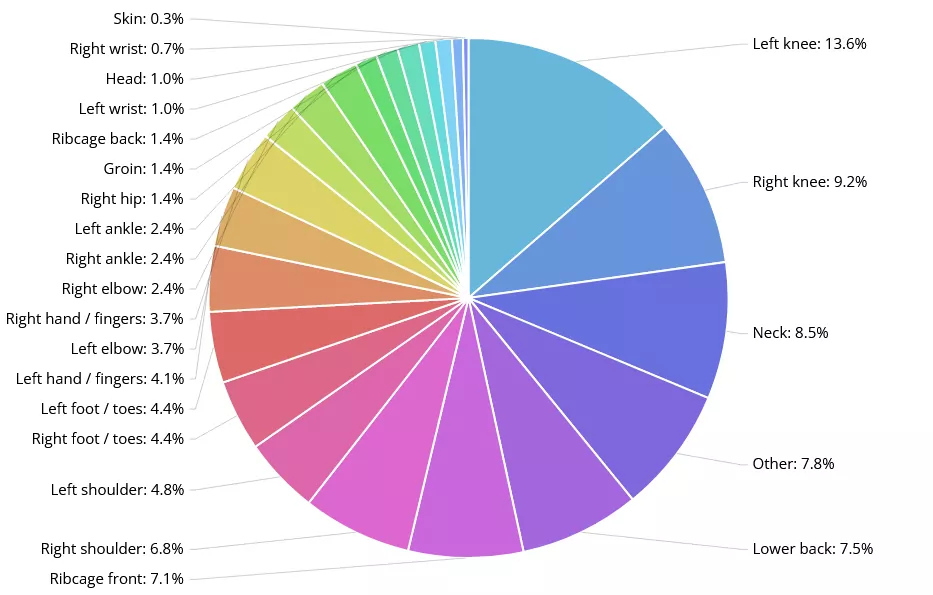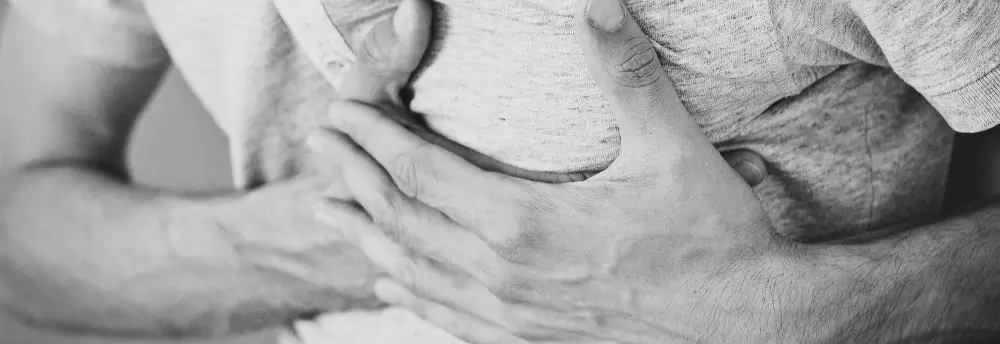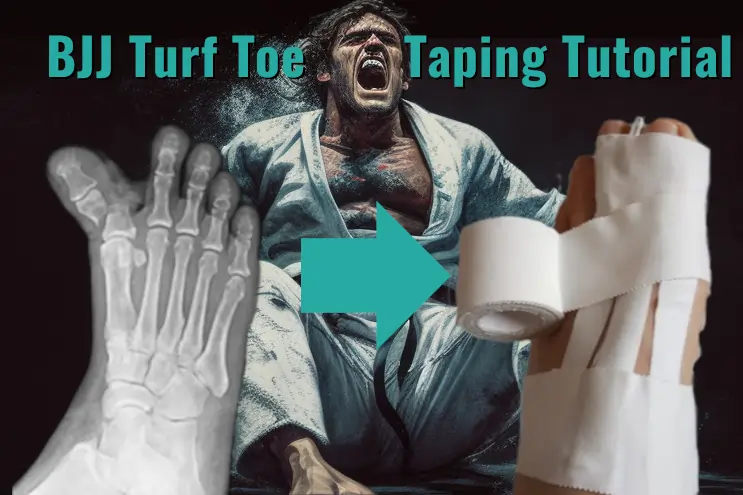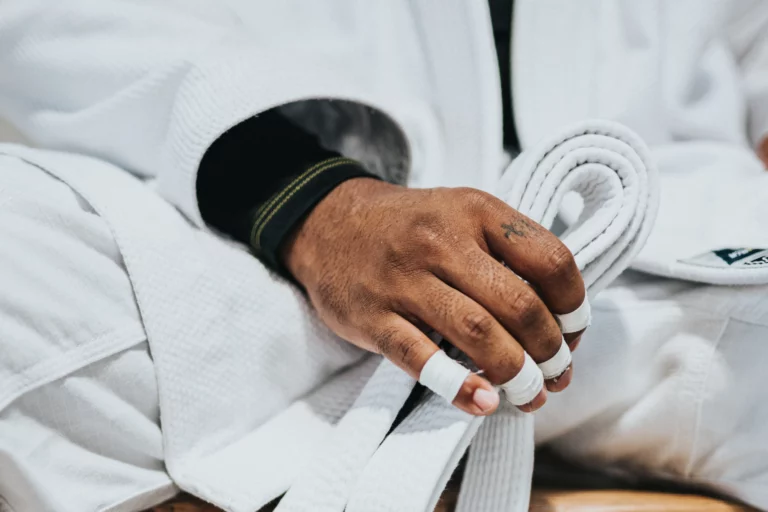BJJ Rib Injury: 3 Common Injuries, Training, and Recovery

Did you ever have to deal with BJJ rib injury?
The chances are high, as rib injuries are among the most common injuries in Brazilian Jiu Jitsu. For further information on the commonality of BJJ injuries, check out our in-depth BJJ injury statistics in our dedicated post.
In this article, we will discuss the most common types of BJJ rib injuries, how to manage and treat rib pain, tips for training with a rib injury, and effective recovery methods.
Disclaimer: The content of this page does not replace professional medical advice.
BJJ Rib Injury FAQ
Common BJJ Rib Injuries
BJJ rib injuries can occur due to several reasons, such as being pinned down or twisted during sparring, impact forces, or overuse.
The following image shows Brazilian Jiu Jitsu injury statistics from beltchecker, which show that rib injuries make up 8.5% of all BJJ injuries if we consider front- and back-rib injuries. In our experience, finger and toe injuries are most common in Jiu Jitsu.

The most common types of BJJ rib injuries include:
1. Rib Contusions
Rib Contusions are defined as bruising of the rib cage due to impact. Symptoms include tenderness, swelling, and pain when taking in case of any movement, including deep breaths.
2. Rib Fractures
Rib Fractures are defined as a break in the rib bones due to a forceful impact or excessive pressure. Symptoms are similar to the symptoms of rib contusions but more severe. They include intense pain, difficulty breathing, and swelling.
3. Intercostal Muscle Strain
Intercostal Muscle Strains are defined as strains in the muscles between the ribs due to overuse or sudden twisting movements. Symptoms include pain when taking deep breaths, twisting, and especially when performing the injury movement.
BJJ Rib Pain

Rib pain can be severe and often not only affects your training routine but also your day-to-day quality of life. Insufficient rest can further elevate the pain, especially if left untreated.
For most injuries in general, the RICE method (Rest, Ice, Compress, Elevate) is a good starting point when it comes to treating the injury.
Here is what you can do to treat BJJ rib injury and rib pain:
Rest
Easier said than done. You must make sure to take a break from BJJ training and allow your ribs to heal, even if you are eager to train.
Ice
To avoid swelling of the injured area, which slows down the recovery process, apply ice to the affected area for 15-20 minutes. Do this several times a day to reduce pain and swelling.
Pain Relief Medication
Over-the-counter medication such as ibuprofen or acetaminophen/paracetamol can help relieve pain. However, don’t be too generous with pain medication, and don’t make them a habit. Fight the cause, not the symptom.
Training Jiu Jitsu with Rib Injury
Training with a rib injury can be challenging, but it’s not impossible.
After you had sufficient rest, here are some tips for continuing your BJJ training while nursing a BJJ rib injury:
Avoid Certain Techniques
It goes without saying that you should avoid moves that put pressure on your ribs, such as body triangles and takedowns in general.
Communicate with Your Training Partners
Communicating openly with your training partners is the most important aspect of reintroducing training after an injury. Let your training partners know about your injury, and ask them to avoid moves that may aggravate it.
Make sure to only choose training partners you can trust, which is great advice for Jiu Jitsu and martial arts in general.
Use Protective Gear
Using protective gear can be helpful for a wide range of injuries. Although wearing a chest protector or rib brace can help prevent further injury and reduce pain, your discomfort is usually a sign that you shouldn’t be training in the first place.
Nevertheless a rib brace can provide extra support hen reintroducing training after a BJJ rib injury. We recommend a simple rib brace like the following, as it is cheap and won’t restrict movement too much:
BJJ Rib Injury Recovery
Recovering from a BJJ rib injury can take time, but there are a few things you can incorporate to speed up the healing process:
Physical Therapy
Exercises that include light stretching and strengthening can help reduce pain and improve mobility. However, exercising should be reserved for the later stages of the recovery process, and you should take it slow, or you could do more harm than good.
Massage Therapy
Gentle massaging can help increase blood flow, relieve muscle tension, and reduce pain. Listen to your body and proceed according to your pain levels.
Rest and Sleep
It sounds boring, but sleep is the king of recovery. Without high-quality sleep for an adequate time, you won’t be able to function at your best in the long run.
Proper Nutrition
Sleep and proper nutrition are the essentials of human health, and you shouldn’t disregard them when it comes to injury recovery.
Check out our complete guide on BJJ diets and nutrition, which also includes a free calory and macro calculator for BJJ athletes.
Can I Compete in BJJ with a Rib Injury?

Competing in BJJ with a rib injury is a bad idea, as it can worsen your condition and prolong your recovery.
Unless you are a professional athlete or you are striving to become one in the near future, you should take the risk but wait for the next opportunity. Rib injuries can easily be exacerbated by the high-intensity and physical demands of competition.
Keep in mind, there are plenty of Jiu Jitsu competitions every year. If you don’t compete in the next one, you can compete in the one after that.
Floating Rib Injury BJJ
A floating rib injury in BJJ occurs when one of the lower ribs, known as a floating rib, is bruised/contused, dislocated, or fractured. These ribs are called floating ribs since they are only connected to the spine on the back, which makes them less stable and more susceptible to injuries.
As with most other rib injuries, the symptoms include intense pain, swelling, and difficulty breathing. If you suspect you have a floating rib injury, consult a medical professional immediately.
Conclusion
In summary, rib injuries are among the most common injuries in BJJ, but they don’t need intervention most of the time.
As with all injuries, your best bet is to take precautions to prevent rib injuries in the first place. With adequate recovery methods, as the ones explained above, you can heal and get back to training strong and safe.
Nevertheless, always listen to your body and seek medical attention if you experience severe or persistent pain or you didn’t get a proper diagnosis.







